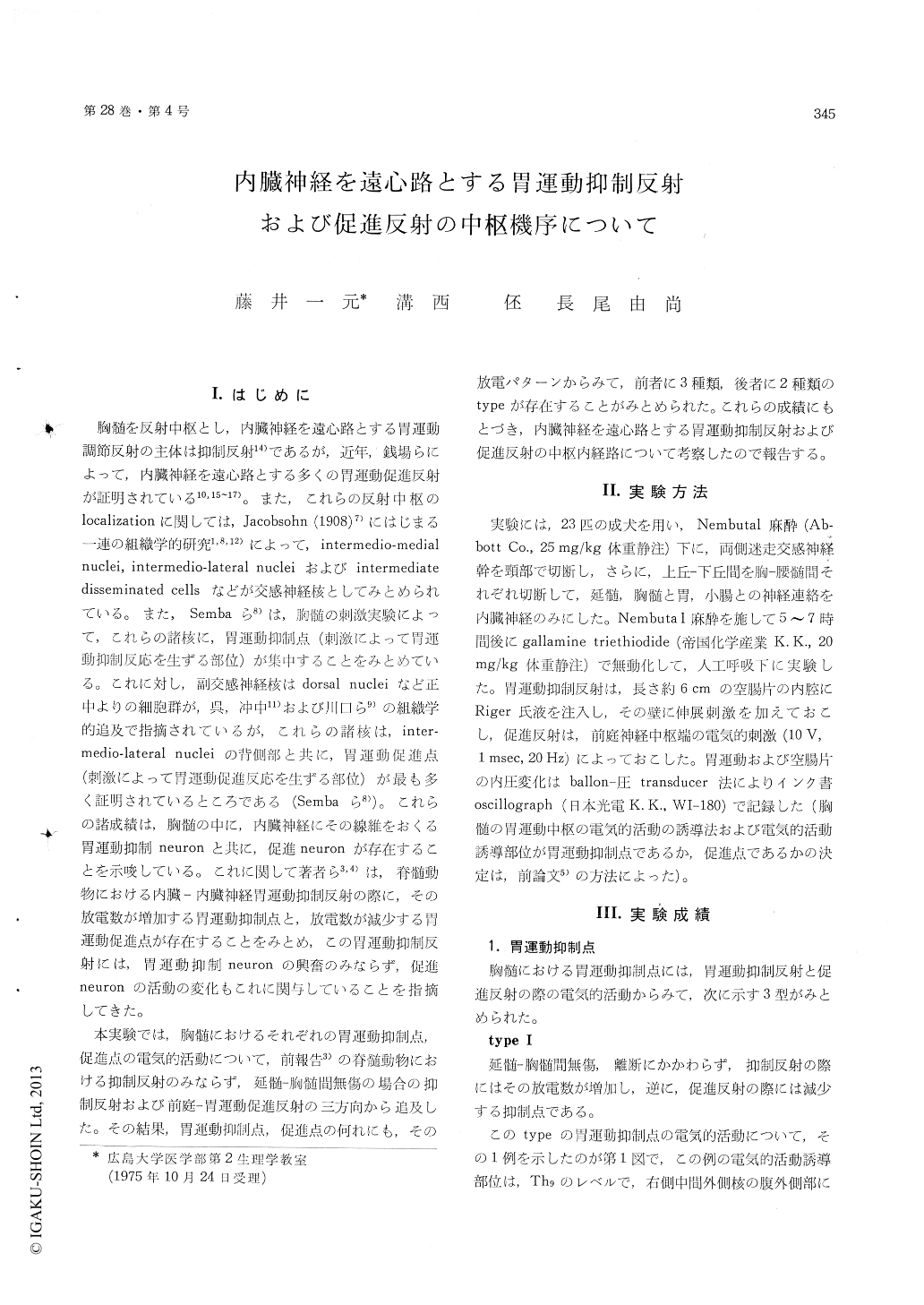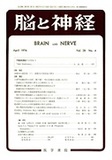Japanese
English
- 有料閲覧
- Abstract 文献概要
- 1ページ目 Look Inside
I.はじめに
胸髄を反射中枢とし,内臓神経を遠心路とする胃運動調節反射の主体は抑制反射14)であるが,近年,銭場らによって,内臓神経を遠心路とする多くの胃運動促進反射が証明されている10,15〜17)。また,これらの反射中枢のlocalizationに関しては,Jacobsohn (1908)7)にはじまる一連の組織学的研究1,8,12)によって,intermedio-medialnuclei,intermedio-lateral nucleiおよびintermediatedisseminated cellsなどが交感神経核としてみとめられている。また,Sembaら8)は,胸髄の刺激実験によつて,これらの諸核に,胃運動抑制点(刺激によって胃運動抑制反応を生ずる部位)が集中することをみとめている。これに対し,副交感神経核はdorsal nucleiなど正中よりの細胞群が,呉,冲中11)および川口ら9)の組織学的追及で指摘されているが,これらの諸核は,inter—medio-lateral nucleiの背側部と共に,胃運動促進点(刺激によって胃運動促進反応を生ずる部位)が最も多く証明されているところである(Sembaら8))。これらの諸成績は,胸髄の中に,内臓神経にその線維をおくる胃運動抑制neuronと共に,促進neuronが存在することを示唆している。これに関して著者ら3,4)は,脊髄動物における内臓一内臓神経胃運動抑制反射の際に,その放電数が増加する胃運動抑制点と,放電数が減少する胃運動促進点が存在することをみとめ,この胃運動抑制反射には,胃運動抑制neuronの興奮のみならず,促進neuronの活動の変化もこれに関与していることを指摘してきた。
本実験では,胸髄におけるそれぞれの胃運動抑制点,促進点の電気的活動について,前報告3)の脊髄動物における抑制反射のみならず,延髄—胸髄間無傷の場合の抑制反射および前庭—胃運動促進反射の三方向から追及した。その結果,胃運動抑制点,促進点の何れにも,その放電パターンからみて,前者に3種類後者に2種類のtypeが存在することがみとめられた。これらの成績にもとづき,内臓神経を遠心路とする胃運動抑制反射および促進反射の中枢内経路について考察したので報告する。
The electrical activities of the gastric motor centers in the dog's thoracic cord were investigated during the intestino-gastric inhibitory and vestibulo- gastric excitatory reflexes. Dogs were anaesthetized with Nembutal and also immobilized with gallamine triethiodide under artificial respiration after several hours of Nembutal anaesthesia. The brain stem was transected in the portion of colliculus, the lower portion of the thoracic cord was transected and the bilateral vagus nerves were severed.
A : The gastric inhibitory areas in the thoracic cord-the stimulation of them produce the in-hibitory responses of gastric movements-may be classified into 3 types (Table 1).
Type I: The electrical activities of the gastric inhibitory areas are augmented during the in-hibitory reflexes independently of transection of the cervical cord, but they are diminished during the excitatory reflexes.
Type II: The electrical activities of the gastric inhibitory areas are augmented during the inhibi-tory reflexes on the animals which the cervical cord are intact, however, the any changes of electri-cal responses on the same inhibitory area are not observed during the excitatory reflexes.
Type III: The electrical activities of the gastric inhibitory areas are augmented during the inhibi-tory reflexes, but no changes are observed after transection of the cervical cord. And also no changes are obtained during the excitatory reflexes.
B: The gastric excitatory areas in the thoracic cord-the stimulation of them produce the excita-tory responses of gastric movements-may be classi-fied into 2 types (Table 2).
Type I: The electrical activities of the gastric excitatory areas are diminished during the inhibi-tory reflexes, but they are augmented during the excitatory reflexes.
Type II: The electrical activities of the gastric excitatory areas are augmented during the excita-tory reflexes, but no changes are obtained during the inhibitory reflexes.

Copyright © 1976, Igaku-Shoin Ltd. All rights reserved.


